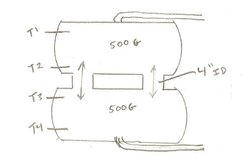I had developed a hypothesis that heating storage to a temperature higher than that needed to provide heat until the next scheduled burn results in burning of a material excess quantity of wood than would result if storage were heated only to the needed temperature. I also had developed a hypothesis that heating storage to temperatures above 185F was inefficient as compared to limiting storage heating to 185F.
The data I collected does not clearly support either of these hypotheses, and based on the data for the burns described below, I cannot conclude that charging storage to a higher temperature results in wasting or inefficient burning of wood.
In Gasser Burns I posted a Wood Loading Chart. I have complete three weighed wood burns based on the Chart, each time using the 80% efficiency table and targeting storage charge temperature of 185F. These were the burns:
** During both of these burns, the radiant called for heat and drew from storage; not realizing target temp was the result of the btu draw on the tank during the burn. There was no call for heat during the third burn, and I am assuming that tank end temp during the first two burns also would have been 187F.
Prior to these Chart burns, I winged my burns, roughly aiming for a 185-190F tank temperature at the end of the burn. Although I thought I was pretty good at estimating the final wood load by "feel and sight" to reach this temperature without idling, pretty good proved to be by no means very good. The four prior burns, showing these results, indicates I tend to burn to a higher tank temperature than my mental target:
Based on lbs of wood per degree of rise in tank temperature, I believe the data does not support the hypotheses, as about 1.7 lbs of wood was needed for each 1 degree rise in tank temperature, regardless of the end temperature. Perhaps you might read the data to draw a different conclusion or have different insights.
I have found one clear benefit of pre-weighing the wood based on the Chart. I can burn the weighed wood load free of an anxiety that the boiler will idle before the load is fully burned.
The data I collected does not clearly support either of these hypotheses, and based on the data for the burns described below, I cannot conclude that charging storage to a higher temperature results in wasting or inefficient burning of wood.
In Gasser Burns I posted a Wood Loading Chart. I have complete three weighed wood burns based on the Chart, each time using the 80% efficiency table and targeting storage charge temperature of 185F. These were the burns:
Code:
. tank start tank target tank end lbs per
date lbs temp temp temp *F
01/11 84 138 185 175 ** 1.71 **
01/13 119 117 185 175 ** 1.70 **
01/15 139 105 185 187 1.70** During both of these burns, the radiant called for heat and drew from storage; not realizing target temp was the result of the btu draw on the tank during the burn. There was no call for heat during the third burn, and I am assuming that tank end temp during the first two burns also would have been 187F.
Prior to these Chart burns, I winged my burns, roughly aiming for a 185-190F tank temperature at the end of the burn. Although I thought I was pretty good at estimating the final wood load by "feel and sight" to reach this temperature without idling, pretty good proved to be by no means very good. The four prior burns, showing these results, indicates I tend to burn to a higher tank temperature than my mental target:
Code:
. tank start tank target tank end Chart lbs per
date lbs temp temp temp lbs *F
01/03 187 84 185+/- 187 172 1.82
01/05 156 103 185+/- 194 142 1.71
01/07 150 112 185+/- 197 126 1.76
01/09 176 107 185+/- 198 135 1.74Based on lbs of wood per degree of rise in tank temperature, I believe the data does not support the hypotheses, as about 1.7 lbs of wood was needed for each 1 degree rise in tank temperature, regardless of the end temperature. Perhaps you might read the data to draw a different conclusion or have different insights.
I have found one clear benefit of pre-weighing the wood based on the Chart. I can burn the weighed wood load free of an anxiety that the boiler will idle before the load is fully burned.



